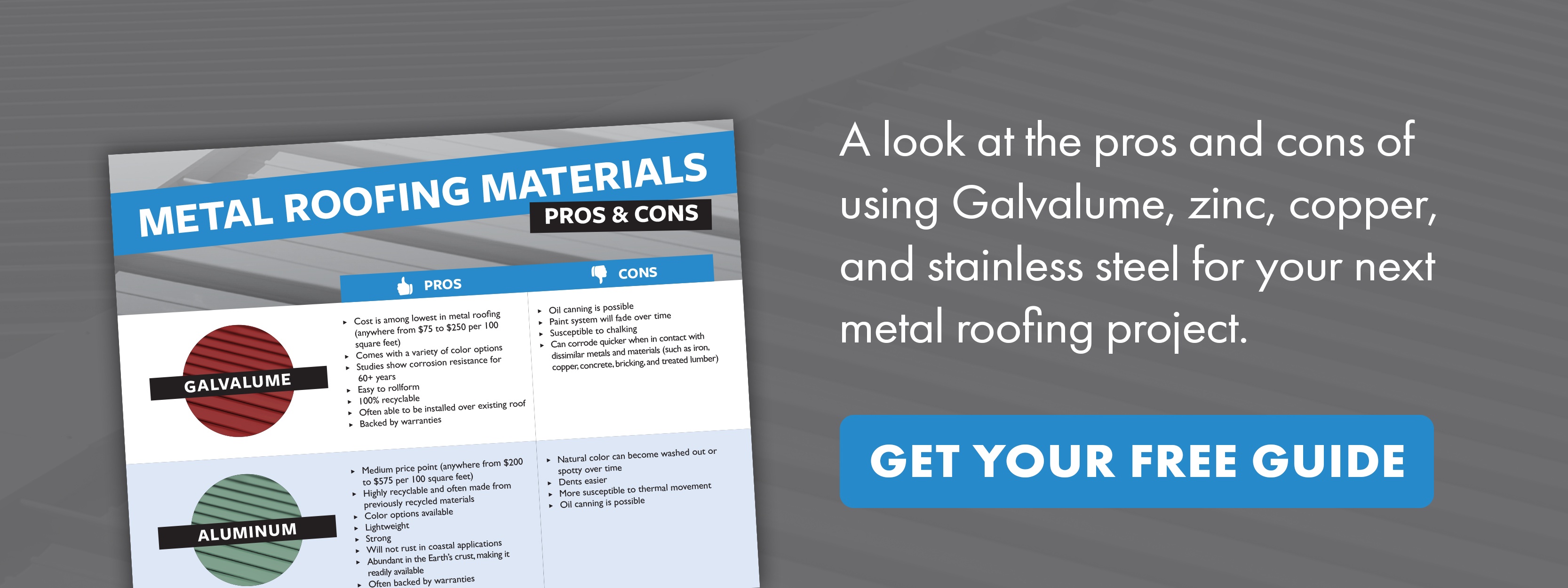Misconceptions will always exist, as they are an inevitable part of nearly all products and services.
Some misconceptions and misnomers related to metal roofing products are harmless and just a misunderstanding. However, there are also misconceptions that could change perceptions and steer consumers in the wrong direction.
At Sheffield Metals, we believe it’s important to set the record straight by educating you about the top five misconceptions that we hear in the metal roofing industry all the time, plus an explanation of why it is a just a misconception.
In this article, expect to learn the truth about:
- PVDF vs. Kynar®
- The importance of engineered products
- Paint system warranties
- Hail rated vs. hail proof roofing
- Galvalume® and similar products
Product Misconception #1: PVDF Paint Systems Are Also Called Kynar®
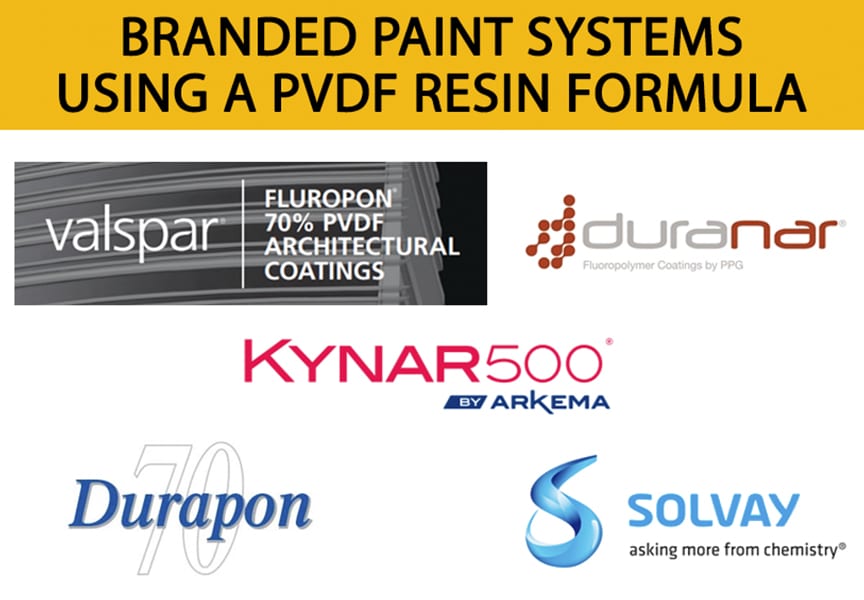
One of the most common misconceptions out in the industry is when a polyvinylidene fluoride (PVDF) paint system is referred to as “Kynar.” While this is partially true, Kynar does not represent all PVDF products and is actually just one of the brands that use a PVDF resin formula in its products. Kynar is a product line owned by Arkema.
For reference, PVDF is defined as the resin made up of about 70% polyvinylidene fluoride and 30% acrylic. PVDF resins are considered one of the best protective coatings available and stand up well to extreme temperatures, sun exposure, oxygen, humidity, and even pollution particles in the atmosphere. There are also coastal formulations and corrosive environment formulations of PVDF and are available as high-end and more expensive items.
The way Kynar relates to PVDF is similar to how Kleenex relates to tissues. The word “Kleenex” is commonly used in place of “tissue,” even though Kleenex is just a brand name (like Kynar) and not an actual product category (like PVDF).
Other Branded PVDF Products
There are tons of different products that are similar to Kynar and are also considered PVDF products, including:
- Fluropon® (owned by Valspar/Sherwin Williams)
- Hylar® 5000 (owned by Solvay)
- DURANAR® (owned by PPG)
- Durapon 70™ (owned Dura Coat Products, Inc. and licensed by Hylar 5000)
- Kynar® 500 (owned by Arkema)
While all of these products are good choices, the PVDF paint system is only as good as the primer, film thickness, and environment that the finished product is exposed to. This is why it’s essential to make sure the product you’re installing or buying is valid for the application.

Product Misconception #2: Engineered Products Aren’t a Necessity
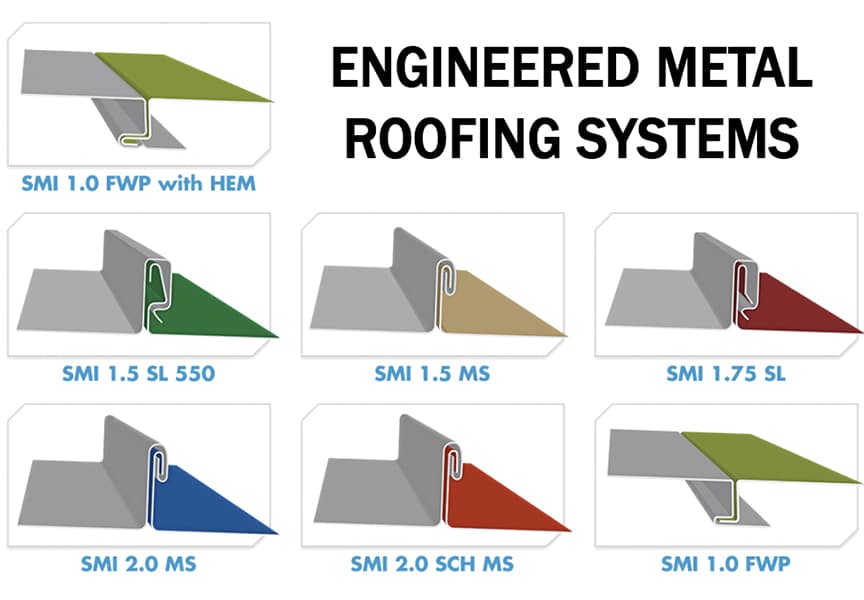
There is a misconception out there that engineered metal roofing systems are more of a “nice-to-have,” rather than a necessity, which isn’t true. In fact, at Sheffield Metals, we always recommend using an engineered system just to be safe and to ensure you’re getting the most protection from wind, water, hail, fire, and otherwise.
First and foremost, we want to mention that engineered metal roofing systems, which are tested in a third-party lab and adhere to strict metal roofing industry standards, might not be a necessity in some situations. However, engineered system or no engineered system, it is an absolute requirement that all buildings meet county/local building codes. Also, whoever is pulling the permit should be submitting documentation about the product they are installing as the new roof. (Note: Just because something has a UL construction number doesn’t mean that it’ll meet local building codes or is an engineered system).
Engineered systems tend to be used more in commercial projects rather than residential because many localities require it and also because of the size, complexity, and functionality of commercial buildings. If you want to know if it’s a requirement for your home or building, contact your local building department to check. Even if it’s not legally required, you should always have the option to choose an engineered profile.
Product Misconception #3: All Paint System Warranties Are the Same
Paint system warranties are just one of the major selling points for a metal roof, mainly because a warranty usually means the paint is tested and proven to withstand the elements. That being said, there is a misconception that all paint warranties are basically the same and that the number of years stated at the top of the document applies to all forms of wear and tear.
Unfortunately, this is untrue.
The number of years advertised at the topic is often specific to film adhesion, which includes cracking, peeling, and chipping of the paint system for the stated period of time. If you look closer, you’ll see that chalking and fading of the paint system are typically covered for FEWER years than the number provided at the top of the warranty. Plus, keep in mind that PVDF paint finish warranties cover chalk and fade for a longer span of time with a better chalk and fade rating than SMP (silicone-modified polyester) paint systems.
Understanding a Paint Warranty
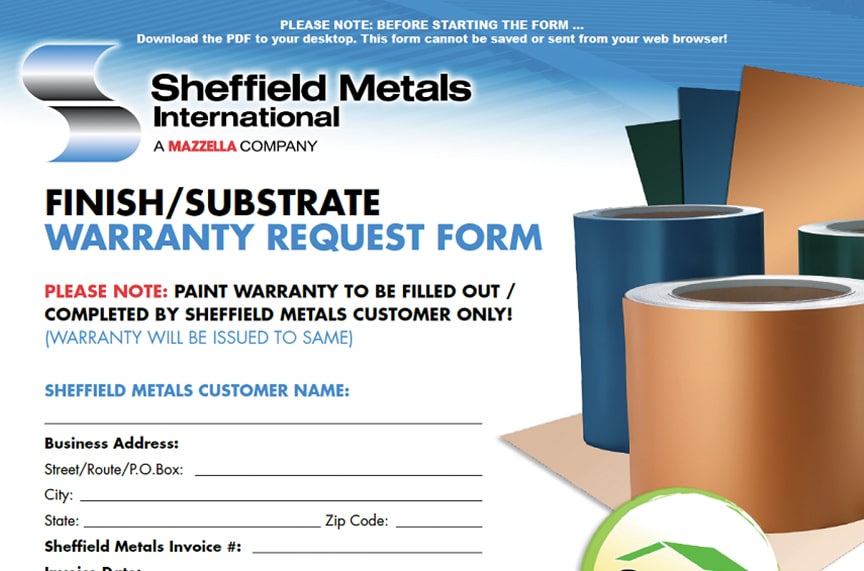
In addition to the warranty coverage not being the same for all paint systems, we also want to briefly discuss the importance of thoroughly reading the paint warranty and knowing what is and isn’t covered. In addition to exclusions, you’ll want to look at all of the fine print and avoid manufacturers that have pages upon pages of exclusions.
That being said, here are some common factors that aren’t covered by a paint warranty (this will vary by manufacturer):
- “Acts of God” (i.e., hurricanes, wind, etc.)
- Fire damage
- Deliberate damage or alterations
- Accidental damage (i.e., dropping chemicals on the surface, etc.)
- Improper handling by installers
- Exposure to animals or animal waste
- Foreign/destructive substances in the environment and/or inside of the structure (i.e., within a certain distances of coastlines with breaking surf, large bay or marsh areas, beyond the water’s edge, in proximity to corrosive chemicals, ash, fumes cement dust, copper or lead runoff, silver or nickel mining, carbon black, or treated lumber)
- After-the-fact additions to a roof that may affect the chemical make-up, like adhered solar panels, snow guards, etc.
- Complimentary roof products, fasteners, or penetrations that could cause a galvanic reaction and ruin the finish or corrode the metal
Product Misconception #4: Hail Rated Roofing Products Are Hail Proof
Another misconception we hear about all the time is that metal roofing is hail proof. While metal roofing offers one of the best defenses against hail and is generally hail-rated, it’s actually not 100% hail proof. Given the right circumstances and size of the ice pellets, hail can penetrate the surface of a metal roof and create a whole mess of roofing problems.
Industry Standard Testing for Hail Rating
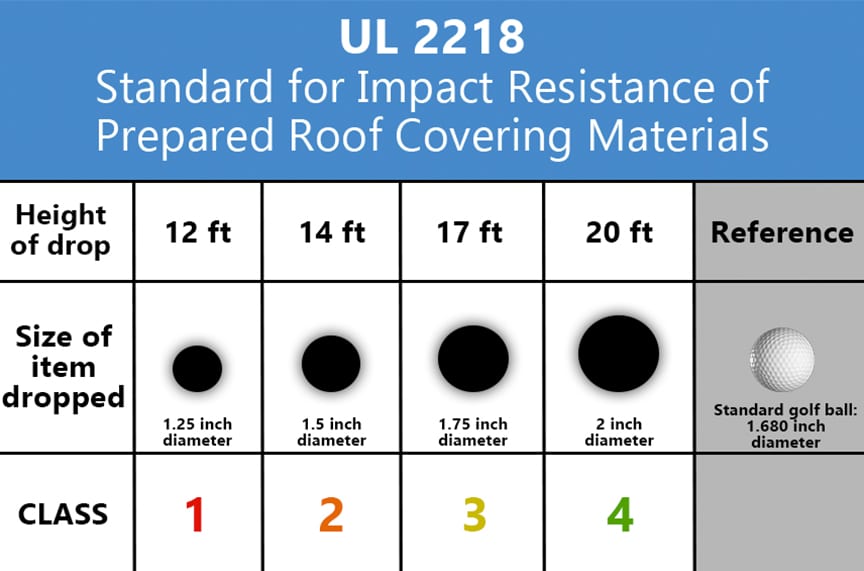
To combat this and make sure that the metal will withstand hail, look at the product’s UL 2218 test rating (Standard for Impact Resistance of Prepared Roof Covering Materials). UL 2218 exists to test a metal panel’s resistance to puncturing or failing when it comes into contact with items, such as hail or other small debris.
The test evaluates the effect of impact from a steel ball at locations on the assembly selected to be most vulnerable, such as (but not limited to) edges, corners, unsupported sections, and joints.”
Four steel balls of different sizes are dropped from varying heights onto the metal panels. The test evaluates the effect of impact from a steel ball at locations on the assembly selected to be most vulnerable, such as (but not limited to) edges, corners, unsupported sections, and joints. The system is then evaluated to see if punctures or other failures have occurred. Rating is determined on a scale from Class 1 to 4, with Class 4 being the least likely to fail when in contact with falling objects.
Insurance and Hail Aesthetic Damage Waivers
Many homeowner’s insurance companies offer “hail damage waivers,” which lower premium prices but waives the insurance company from covering a claim for repairs or replacements for aesthetic damage caused by hail falling on a metal roof. If the home or building is in a location where hailstorms are common or strong, it is likely not worth the savings.
Just be aware that these kinds of waivers exist and make sure to do your research or ask the manufacturer before signing.
Product Misconception #5: Galvalume® Is the Only Material of its Kind
Galvalume is a trademarked metal coating introduced to the industry in the early 1970s by Bethlehem Steel, which consists of approximately 55% aluminum, 43.4% zinc, and 1.6% silicone. To apply the Galvalume coating, a metal base substrate is continuously hot-dipped until it reaches the desired thickness/weight. The most common substrate associated with Galvalume is cold-rolled steel.
Galvalume as a product in the architectural metals context can be considered one-of-a-kind because there aren’t many coated steel products that possess the self-healing characteristics that Galvalume does when it’s perforated, plus it often carries a warranty and doesn’t deteriorate as dramatically or as severe as galvanized metal does. That being said, similar or the same products exist elsewhere under a different name, such as ZINCALUME® (owned by Steelscape, LLC).
More Galvalume Facts & Clarifications
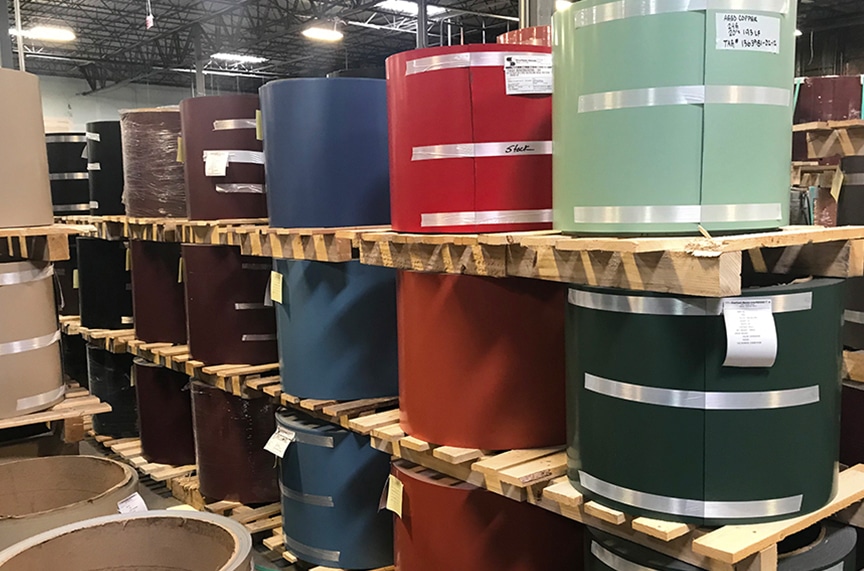
AZ50 vs. AZ55
Have you heard Galvalume be referred to as AZ50 or AZ55? These abbreviations actually just mean “Aluminum Zinc 50” and “Aluminum Zinc 55,” and the numbers indicate the coating weight.
- AZ50 = 0.50 ounces per square foot of the aluminum-zinc alloy coating have been applied to both sides of the substrate.
- This is the typical coasting weight for architectural metal that is painted.
- AZ55 = 0.55 ounces per square foot of the aluminum-zinc alloy coating have been applied to both sides of the substrate.
- This is the typical coating weight for bare, un-painted architectural metal.
ACRYLIC-COATED GALVALUME
Acrylic-coated Galvalume is another kind of Galvalume product that has a little bit of a heavier coating weight (AZ55) and includes a light acrylic coating that protects the Galvalume coating in the manufacturing process. This acrylic coating will wear off over time when exposed to weather. Even though not painted, these products still need to be handled with care, or you risk scuffing or perforating the Galvalume coating.
Some other acrylic-coated Galvalume products are known as:
- Galvalume Plus®
- Zincalume® Plus
- DREXLUME™ (owned by Drexel Metals)
- Aluzinc® (owned by ArcelorMittal)
Final Thoughts on Metal Roofing Product Misconceptions
With so many products and available options for metal roofing, it’s no wonder that so many misconceptions exist. As mentioned, most are harmless but are still important to correct.
The best way to make sure you know the truth when buying or selling metal roofing products is to stay educated and know what questions to ask when faced with a potential misconception. Remember:
- PVDF is a paint system, and Kynar is a just a brand name for a PVDF system.
- Using engineered products is the best way to ensure a roofing system will perform to high standards.
- Read the fine print in a paint warranty; coverage often differs from the advertised number of years for specific occurrences.
- Hail-rated roofs are NOT hail proof; just less likely to puncture if given a higher class rating.
- Galvalume is another trade name for a coating consisting of aluminum, zinc, and silicone, and is similar/the same as other trademarked products.
After 20 years of manufacturing and distributing metal roofing sheets, coils, and other related products, Sheffield Metals has come across many misconceptions. That’s why we believe setting the record straight can help to strengthen the industry as a whole.
To ask one of our experienced metal roofing specialists about a misconception you’ve heard or if you want to schedule a consultation, please contact us today.
